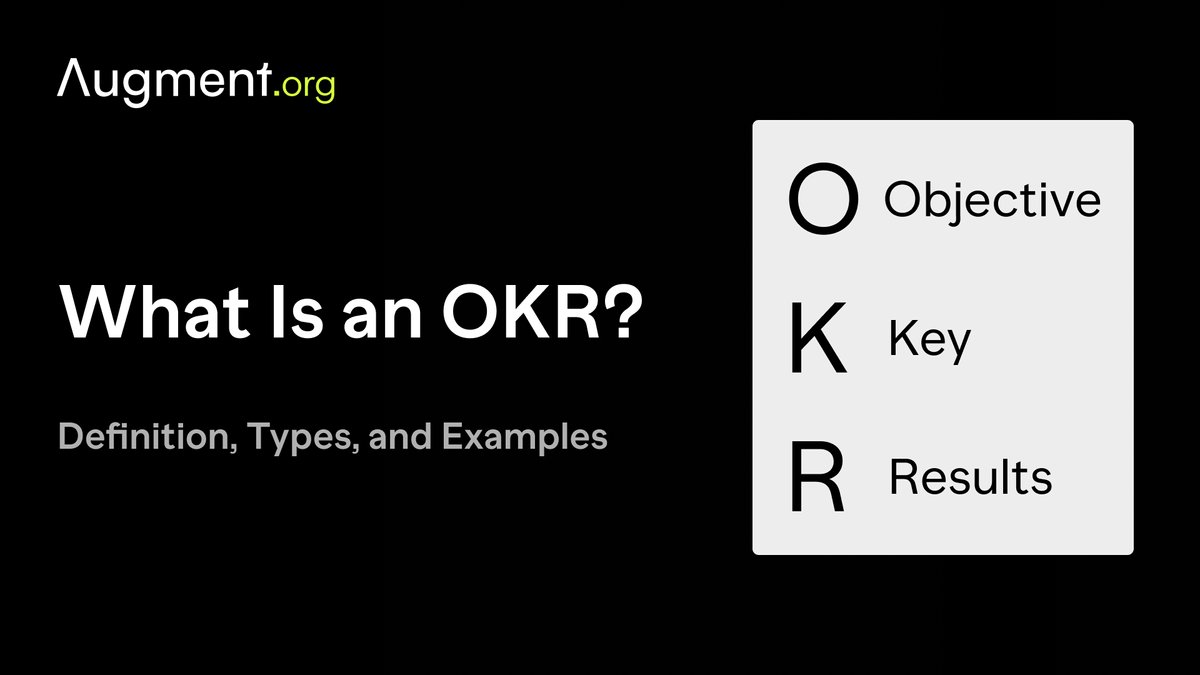What Is an OKR? Definition, Types, and Examples
OKR stands for Objectives and Key Results. It is a goal-setting tool that helps organizations define clear objectives and track their progress with measurable results. OKRs align individual and team efforts with the company's strategic goals, enhancing focus, accountability, and performance.

What is an OKR?
An OKR, which stands for Objectives and Key Results, is a powerful goal-setting framework used to define and track objectives within an organization. In essence, it serves as a tool to help businesses set clear and measurable goals and then measure progress towards achieving them. OKRs are more than just a set of targets; they provide a structured approach for aligning the entire organization, from individual team members to the company's high-level strategy.
An OKR consists of two key components: the Objective and the Key Results. The Objective defines what you want to achieve, typically in a concise and aspirational manner. Key Results are specific, measurable outcomes that indicate progress towards the Objective. Together, these components create a framework that fosters focus, alignment, and accountability across the organization.
Origins of the OKR Methodology
The OKR methodology, which has become a cornerstone of effective goal-setting in businesses today, has an intriguing history. It was first introduced by Intel Corporation in the 1970s. The company's co-founder, Andy Grove, and his colleagues developed the concept to enhance organizational performance by setting clear objectives and measuring results. Initially, it was used internally at Intel to drive success and was eventually adopted by other technology companies.
The essence of OKRs—setting ambitious goals and tracking key results—quickly gained recognition for its effectiveness in promoting alignment, focus, and accountability within organizations. Over time, it expanded beyond the tech industry and found applications in various sectors, becoming a widely recognized management methodology. Today, OKRs represent an essential aspect of many successful companies' strategies, guiding them toward their objectives and improving business performance.
Types of OKRs
OKRs can take various forms, tailored to meet specific needs and objectives within an organization. Here are some common types of OKRs you may encounter:
- Individual OKRs: These are objectives and key results set by individual team members to align their work with the broader goals of the organization. Individual OKRs help employees understand their roles in achieving company objectives.
- Team OKRs: Team OKRs focus on collective goals and outcomes within a specific team or department. They promote collaboration and ensure that team efforts contribute to the overall success of the organization.
- Company OKRs: These are high-level objectives set by the company's leadership to guide the organization's strategic direction. Company OKRs cascade down to teams and individuals, ensuring alignment across all levels.
- Stretch Goals: Stretch goals are ambitious objectives that challenge teams or individuals to push their limits and achieve outstanding results. They encourage innovation and growth.
- Business Goals: Business goals encompass objectives related to the core operations and growth of the company. They often revolve around revenue, customer acquisition, and market expansion.
- Employee Engagement OKRs: These focus on improving employee satisfaction, motivation, and performance. They may include objectives related to professional development, work-life balance, and team collaboration.
Benefits of OKRs
OKRs offer a wide range of benefits to organizations of all sizes and across various industries. Here are some key advantages:
- Focus and Clarity: OKRs help teams and individuals prioritize their efforts by setting clear objectives. This focus ensures that everyone understands what needs to be achieved.
- Alignment: OKRs align teams and individuals with the company's strategic goals, creating a sense of purpose and direction throughout the organization.
- Accountability: The measurable nature of key results holds individuals and teams accountable for their progress, fostering a culture of ownership.
- Adaptability: OKRs allow organizations to adapt to changing circumstances and pivot quickly when needed, ensuring agility in today's dynamic business environment.
- Employee Engagement: Engaging employees in the goal-setting process and recognizing their contributions can boost morale and motivation.
- Improved Performance: By tracking key results, organizations can identify what's working and what needs improvement, leading to better overall performance.
- Transparency: OKRs provide transparency at all levels of the organization, enabling leaders to monitor progress and make informed decisions.
- Innovation: Setting ambitious goals encourages innovation and pushes teams to think outside the box to achieve them.
How to Write an OKR
Crafting effective OKRs involves a strategic approach to ensure they drive the desired outcomes. Here's a simplified guide on how to write OKRs:
- Start with Clear Objectives: Begin by defining your objectives, which should be specific, concise, and aspirational. Objectives should answer the question 'What do we want to achieve?'
- Choose Measurable Key Results: Key results are the measurable outcomes that indicate progress toward your objectives. Ensure they are quantifiable and specific, providing a clear picture of success.
- Keep Them Ambitious Yet Achievable: OKRs should push teams or individuals to excel but remain within reach. Striking the right balance between ambition and achievability is essential.
- Align with Organizational Strategy: Ensure that your OKRs are in alignment with your company's strategic goals. This alignment ensures that everyone is working in the same direction.
- Create OKRs Regularly: OKRs are not static. They should be set, monitored, and updated regularly to adapt to changing circumstances and priorities.
- Foster Alignment and Collaboration: Share OKRs across teams to foster alignment and collaboration. This transparency ensures that everyone understands how their work contributes to the organization's success.
- Measure Progress: Continuously track progress against key results. Utilize key performance indicators (KPIs) to gauge success and identify areas that may need adjustments.
- Review and Reflect: At the end of a designated period, assess your OKRs. Celebrate achievements and learn from any shortcomings to improve future OKRs.
Examples of OKRs
To provide a clearer understanding of how OKRs work in practice, here are a few examples:
- Objective: Increase Customer Satisfaction
- Key Result: Achieve a Net Promoter Score (NPS) of 75 or higher by the end of the quarter.
- Key Result: Resolve 95% of customer support inquiries within 24 hours.
- Objective: Improve Business Performance
- Key Result: Increase quarterly revenue by 15% compared to the previous quarter.
- Key Result: Reduce operational costs by 10% within six months.
- Objective: Enhance Employee Engagement
- Key Result: Conduct regular feedback surveys, with a minimum 80% employee participation rate.
- Key Result: Implement at least two employee development programs within the next quarter.
These examples illustrate the alignment of objectives with measurable key results. Each objective is specific, actionable, and has corresponding key results that provide a clear path to success.
Common OKR Mistakes
Here are some common pitfalls to watch out for when setting OKRs:
- Setting Vague Objectives: Failing to define clear and specific objectives can lead to confusion and lack of focus. Objectives should be precise and actionable, leaving no room for interpretation.
- Neglecting Measurable Key Results: Measurable key results are the heart of OKRs. Skipping this crucial step or setting results that aren't quantifiable can make it challenging to gauge progress accurately.
- Losing Sight of Alignment: OKRs should be aligned with the organization's strategic goals. A lack of alignment can lead to teams working in different directions, resulting in inefficiency and wasted effort.
- Overloading Objectives: Trying to tackle too many objectives at once can dilute focus and effectiveness. It's essential to prioritize objectives to ensure they receive the necessary attention and resources.
- Failing to Update OKRs: OKRs should not be set in stone. Circumstances change, and goals may need adjustment. Not updating OKRs regularly can hinder adaptability and hinder progress.
- Ignoring Team Involvement: Involving team members in OKR setting can boost engagement and ownership. Neglecting their input can lead to a lack of commitment and enthusiasm.
- Neglecting the 'Why': Providing context behind objectives is essential. Team members should understand why an objective matters and how it contributes to the bigger picture.
- Not Reviewing Progress: Regularly tracking progress against key results is crucial. Failing to do so can result in missed opportunities for improvement and course correction.
- Setting Unattainable Goals: While OKRs should be ambitious, they should still be attainable. Setting objectives that are too far out of reach can demotivate teams and lead to frustration.
- Ignoring OKR Cycle: OKRs have a natural lifecycle, and each phase is essential. Neglecting any part of the cycle, such as planning, execution, or reflection, can undermine the effectiveness of OKRs.
By being aware of these common mistakes, you can better navigate the world of OKRs and ensure that your organization benefits from this goal-setting methodology.



